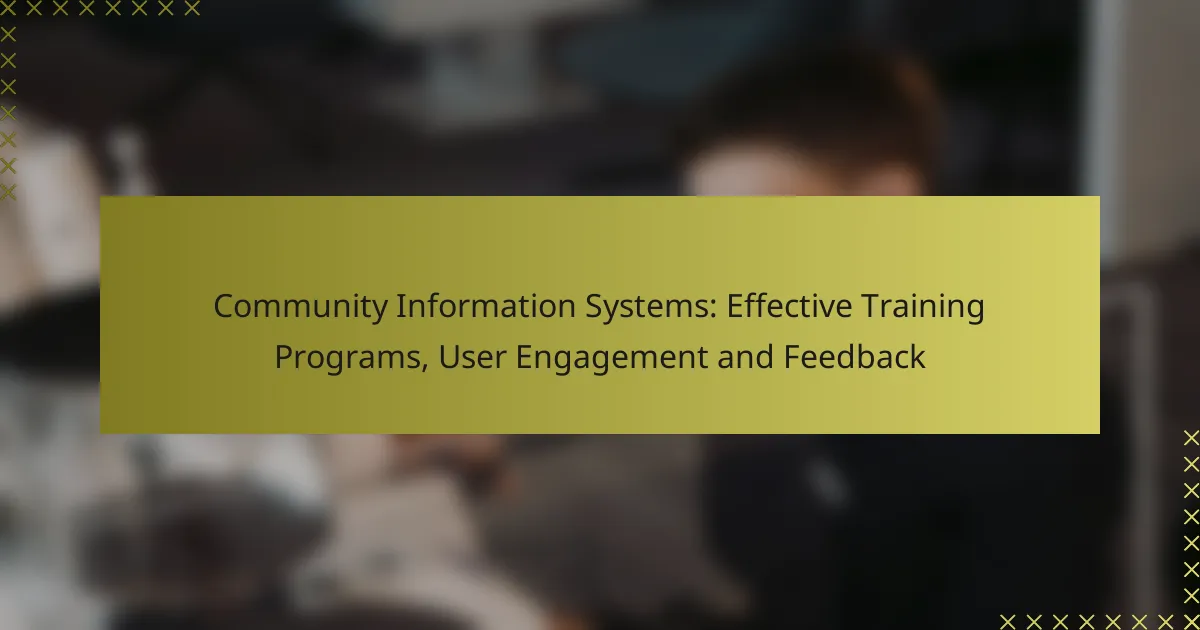Community development is essential for enhancing the quality of life in urban areas, focusing on resident engagement, local asset utilization, and stakeholder collaboration. By examining successful case studies, we can identify effective strategies that lead to measurable outcomes, ultimately fostering resilient and thriving communities.

What are effective community development strategies in urban areas?
Effective community development strategies in urban areas focus on engaging residents, leveraging local assets, and fostering collaboration among stakeholders. These strategies aim to improve quality of life, enhance economic opportunities, and build resilient communities.
Participatory planning
Participatory planning involves engaging community members in the decision-making process regarding urban development. This approach ensures that the voices of residents are heard, leading to more relevant and accepted outcomes. Techniques include public forums, surveys, and workshops to gather input and feedback.
To implement participatory planning effectively, it is essential to create an inclusive environment that encourages diverse participation. Consider using digital platforms to reach a broader audience, especially younger demographics who may prefer online engagement.
Asset-based community development
Asset-based community development (ABCD) focuses on identifying and utilizing the strengths and resources within a community rather than solely addressing its needs. This strategy empowers residents to leverage local assets, such as skills, networks, and institutions, to foster sustainable development.
For successful ABCD, conduct an asset mapping exercise to catalog resources and talents available in the community. This can include local businesses, schools, and active community members who can contribute to initiatives and projects.
Collaborative governance
Collaborative governance refers to the partnership between government entities, community organizations, and residents to address urban challenges. This strategy promotes transparency, shared decision-making, and collective responsibility for community outcomes.
Establishing clear roles and responsibilities among stakeholders is crucial for collaborative governance. Regular meetings and open communication channels can help maintain engagement and ensure that all parties are aligned with community goals.
Social capital building
Social capital building focuses on creating networks and relationships among community members to enhance trust and cooperation. Strong social ties can lead to increased civic engagement and collective action, which are vital for effective community development.
To foster social capital, organize community events, workshops, and volunteer opportunities that encourage interaction among residents. These activities can help break down barriers and build a sense of belonging and shared purpose.
Public-private partnerships
Public-private partnerships (PPPs) involve collaboration between government agencies and private sector entities to fund and implement community development projects. This approach can leverage additional resources and expertise, leading to more innovative solutions for urban challenges.
When forming PPPs, it is important to establish clear objectives and expectations from both parties. Consider drafting formal agreements that outline roles, funding contributions, and performance metrics to ensure accountability and success in achieving community goals.

How do successful community development projects measure outcomes?
Successful community development projects measure outcomes through a combination of quantitative and qualitative methods that assess the effectiveness of initiatives. These methods provide insights into social, economic, and community well-being, helping stakeholders understand the impact of their efforts.
Social impact assessments
Social impact assessments evaluate the effects of community development projects on social structures and relationships. They often involve analyzing changes in community cohesion, access to services, and overall quality of life. Engaging community members in the assessment process ensures that their perspectives and experiences are accurately captured.
To conduct a social impact assessment, consider using tools like focus groups, interviews, and case studies. These methods can reveal both positive and negative outcomes, allowing for a comprehensive understanding of the project’s social implications.
Community satisfaction surveys
Community satisfaction surveys gather feedback directly from residents about their experiences and perceptions of development initiatives. These surveys can cover various aspects, including service delivery, infrastructure improvements, and overall community engagement. High response rates are crucial for obtaining reliable data.
When designing a survey, focus on clear, concise questions that address specific project components. Aim for a mix of quantitative ratings and open-ended questions to capture nuanced feedback. Regularly conducting these surveys helps track changes in community sentiment over time.
Economic indicators tracking
Tracking economic indicators is essential for understanding the financial impact of community development projects. Key indicators may include employment rates, income levels, and local business growth. Monitoring these metrics helps assess whether projects contribute to economic vitality.
Utilize existing data sources, such as government reports or local economic development agencies, to gather relevant information. Comparing economic indicators before and after project implementation can provide valuable insights into the project’s effectiveness.
Longitudinal studies
Longitudinal studies involve collecting data over an extended period to observe changes and trends resulting from community development projects. This method allows for a deeper understanding of long-term impacts and sustainability. It can highlight how community dynamics evolve over time.
To implement a longitudinal study, establish a clear timeline and consistent data collection methods. Engaging with participants throughout the study can enhance retention and ensure that the data remains relevant. This approach is particularly useful for assessing the lasting effects of initiatives on community well-being.

What are notable case studies in community development?
Notable case studies in community development showcase effective strategies that have led to significant improvements in urban areas. These examples illustrate various approaches that can be adapted to different contexts, emphasizing the importance of community involvement and tailored solutions.
Detroit’s revitalization efforts
Detroit’s revitalization efforts focus on transforming abandoned properties and enhancing public spaces to stimulate economic growth. Initiatives like the Detroit Land Bank Authority have facilitated the sale and redevelopment of vacant lots, allowing community members to take ownership of their neighborhoods.
Key strategies include partnerships with local businesses and non-profits, which help to create jobs and improve services. The city has seen a resurgence in small businesses, particularly in areas like Corktown and Midtown, where community engagement has been pivotal.
Portland’s urban growth boundary
Portland’s urban growth boundary (UGB) is a land-use planning tool designed to control urban sprawl and protect surrounding farmland. Established in the 1970s, the UGB encourages higher density development within the boundary while preserving green spaces outside.
This approach has led to a vibrant urban core with diverse housing options and efficient public transportation. Residents benefit from reduced commute times and increased access to amenities, making Portland a model for sustainable urban planning.
New York’s community land trusts
New York’s community land trusts (CLTs) provide a unique model for affordable housing and community control over land use. By acquiring land and leasing it to residents, CLTs help prevent displacement and ensure long-term affordability.
These trusts empower communities to make decisions about their development, fostering a sense of ownership and responsibility. Successful examples include the Cooper Square CLT, which has preserved affordable housing in Manhattan for decades.
Chicago’s neighborhood improvement initiatives
Chicago’s neighborhood improvement initiatives focus on enhancing quality of life through targeted investments in infrastructure and community services. Programs like the Neighborhood Opportunity Fund provide grants to local businesses, encouraging economic development in underserved areas.
Additionally, the city’s emphasis on community engagement ensures that residents have a voice in the planning process. Initiatives often include beautification projects, public art installations, and improvements to parks, which collectively contribute to a stronger sense of community identity.

What criteria should be used to select community development initiatives?
Key criteria for selecting community development initiatives include assessing community needs, engaging stakeholders, and evaluating resource availability. These factors ensure that initiatives are relevant, supported, and feasible within the community context.
Community needs assessment
A community needs assessment identifies the specific challenges and opportunities within a community. This process typically involves surveys, interviews, and focus groups to gather input from residents and local organizations.
Effective assessments prioritize issues based on urgency and impact, helping to align initiatives with the most pressing needs. For example, a community facing high unemployment may prioritize job training programs over other initiatives.
Stakeholder engagement
Engaging stakeholders is crucial for the success of community development initiatives. This includes local residents, businesses, government agencies, and non-profits who can provide insights and support.
Building partnerships through regular meetings and collaborative planning helps ensure that initiatives reflect the community’s values and needs. It’s essential to maintain open communication to foster trust and encourage ongoing participation.
Resource availability
Evaluating resource availability involves assessing financial, human, and material resources necessary for implementation. Initiatives should be realistic in terms of funding sources, such as grants, donations, or local government support.
Communities should also consider the skills and time commitments of volunteers and staff. For instance, a small community may rely heavily on volunteer efforts, while larger areas might have access to more professional resources.

How can technology enhance community development?
Technology enhances community development by providing tools that facilitate communication, data analysis, and resource management. By integrating digital solutions, communities can make informed decisions and engage residents more effectively.
Data-driven decision making
Data-driven decision making involves using quantitative and qualitative data to guide community initiatives. By analyzing demographic information, economic trends, and social indicators, community leaders can identify needs and allocate resources more effectively.
For example, a community might use surveys and census data to determine areas with high unemployment rates, allowing targeted job training programs. Utilizing data analytics tools can streamline this process, ensuring decisions are based on solid evidence rather than assumptions.
Online engagement platforms
Online engagement platforms facilitate communication between community members and leaders, fostering collaboration and transparency. These platforms can include social media, dedicated community forums, or mobile apps that allow residents to voice concerns and share ideas.
For instance, a local government might implement a mobile app where residents can report issues like potholes or streetlight outages, ensuring timely responses. Engaging residents through these platforms can increase participation in community events and initiatives.
GIS mapping for resource allocation
Geographic Information Systems (GIS) mapping is a powerful tool for visualizing community data and optimizing resource allocation. By mapping resources such as schools, parks, and healthcare facilities, communities can identify gaps and prioritize investments.
A practical application could involve mapping access to public transportation to ensure underserved areas receive adequate service. GIS can also help visualize demographic changes over time, aiding in long-term planning and development strategies.



